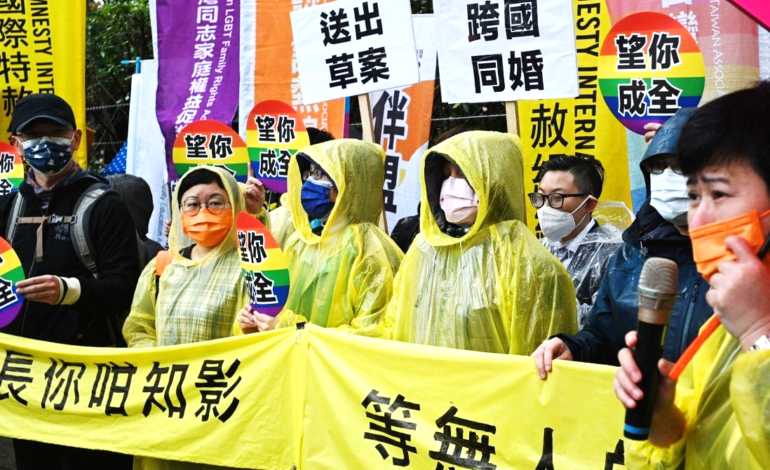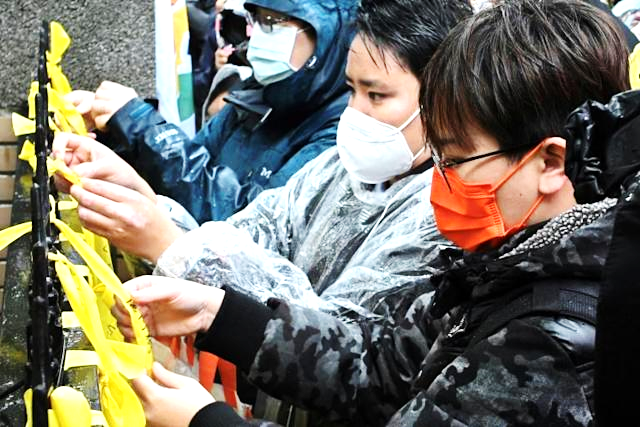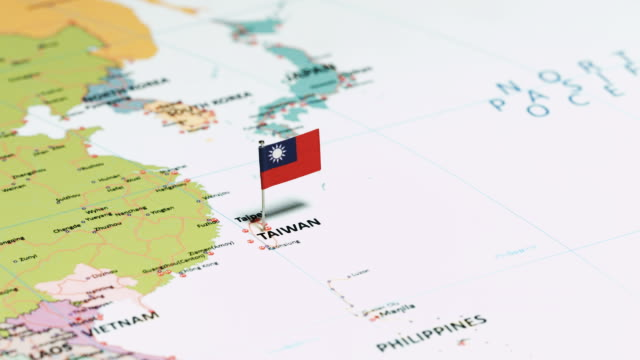
Avellon Williams
TAIWAN- “We don’t just want to be each other’s Valentines, we want to become a real family”. In a protest on Valentine’s Day, LGBTQ activists in Taiwan braved a downpour to voice their displeasure at Taiwan’s same-sex marriage law, which critics say falls short of full recognition for many international couples.
According to Taiwanese law, people can legally marry foreigners, but only from countries that also recognize marriage equality.
Taiwan’s courts have been open to considering challenges on a case-by-case basis, but this requires both partners’ presence, something that is impossible when foreign tourists are prohibited due to the Covid-19 pandemic.
Having been separated from his Japanese partner for more than two years, Andrew Chuang, said, “It’s not me who loves the wrong person, it’s the government that fails to correct its mistake.”
In reference to the 1973 hit song Tie a Yellow Ribbon Round the Ole Oak Tree, in which lovers long for a reunion, protesters tied hundreds of yellow ribbons around the compound’s metal gates.
The ribbons featured names and nationalities of separated couples along with how many days they’ve been apart.

Currently, Taiwan’s foreign population is limited to a few categories, including diplomats, some international students, and migrant workers from a limited number of countries.
The Pandemic is not yet over, and those on work or student visas are fearful of separation in the future.
The partner of Taiwanese social worker Joyce Chan for eight years, Queenie Oyong, is currently on a student visa. However, Queenie is concerned that returning to the Philippines – a country where same-sex marriage is prohibited – could lead to an indefinite separation from Chan.
While kneeling on the ground during her plea to the authorities, Chan said, “We don’t just want to be each other’s Valentines; we want to become a family.”
Reports indicate that at least three couples have won their court challenges and been permitted to marry despite the foreign partner being from a country that doesn’t recognize same-sex marriage.
Having adopted a law in 2019 that established equal marriage rights, Taiwan has seen more than 7,000 same-sex marriages since the law has passed.

RELIGION IN TAIWAN
The Republic of China is the official name of Taiwan, an island just north of the Philippines and southeast of China.
Formerly known as Formosa, it was initially inhabited by Taiwanese aboriginals until the Dutch took over, beginning in 1624 when the Dutch East India Company established its presence in south Taiwan.
Two years later, the arrival of the Spanish in the north of the island contributed to the introduction of Christianity. Having their first contact with Western culture did not help the tribal people appreciate their religion.
With the return of the Dominicans to the south of Taiwan, Christianity re-emerged in 1859. Following the conversion, Christianity spread throughout the south of Taiwan and gradually reached the north.
During the sixteenth century, following the arrival of the Portuguese in Asia in 1498, Taiwan has been part of the Catholic missionary jurisdiction. In Portuguese, it was within the Diocese of Funchal, which was founded in 1514 by the Portuguese. As far as Mainland China and Macau Island were concerned, the Diocese of Macau was established in 1576. Over the centuries, the diocese was divided many times, creating many more in the region.
Many Taiwanese embraced Christianity after Presbyterian missionaries arrived in the 1860s and built schools and medical facilities.
The Chinese nationalist government relocated itself to Taiwan in 1949, and many believers followed.

The Republic of China is the official name of Taiwan, an island just north of the Philippines and southeast of China.
Formerly known as Formosa, it was initially inhabited by Taiwanese aboriginals until the Dutch took over, beginning 1624 when the Dutch East India Company established its presence in south Taiwan.
Two years later, the arrival of the Spanish in the north of the island contributed to the introduction of Christianity. Having their first contact with Western culture did not help the tribal people appreciate their religion.
With the return of the Dominicans to the south of Taiwan, Christianity re-emerged in 1859. Following the conversion, Christianity spread throughout the south of Taiwan and gradually reached the north.
Since the sixteenth century, following the arrival of the Portuguese in Asia in 1498, Taiwan has been part of the Catholic missionary jurisdiction. In Portuguese, it was within the Diocese of Funchal, which was founded in 1514 by the Portuguese. As far as Mainland China and Macau Island were concerned, the Diocese of Macau was established in 1576. Over the centuries, the diocese was divided many times, creating many more in the region.
Many Taiwanese embraced Christianity after Presbyterian missionaries arrived in the 1860s and built schools and medical facilities.
The Chinese nationalist government relocated itself to Taiwan in 1949, and many believers followed.





Recent Comments